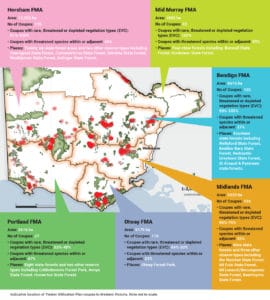PARK WATCH June 2017 |
Our new report clearly demonstrates proposed commercial logging in the west of Victoria should be banned, says our executive director Matt Ruchel.
Until recently the Victorian Government’s logging agency VicForests managed commercial forestry operations only in the east of Victoria. In 2014 it was also handed control of forests in the west.
Now, in February this year, VicForests published its Timber Utilisation Plan, proposing commercial logging in about 60 state forests and woodlands in the west – areas that are historically the most cleared in our state.
In response, we undertook an analysis across the western Victorian forests, with the findings now published in our latest report: Western Forests & Woodlands At Risk.
Mapping the threats
The analysis found 70 per cent of the areas targeted for logging contain native vegetation types that are listed as either endangered (19 per cent), vulnerable (11 per cent), or depleted (40 per cent). In some forestry management areas like Horsham, Mid Murray and Bendigo this jumps up to between 80-100 per cent.
Threatened species have been found either within or near 33 per cent of the planned logging coupes. In certain forest management areas, including the Portland forest management area, that figure leaps to 67 per cent.
In addition, there are 34 threatened species (20 fauna and 14 flora) listed in the forestry codes that have been recorded occurring in or adjacent to coupes listed in the Timber Utilisation Plan, yet no detail has been provided on how the plan addresses these species and relevant code prescriptions.
For example, endangered south-eastern red-tailed black cockatoos have been recorded in 11 proposed coupes in the Horsham and Portland forest management areas. There are thought to be only 1,400 of these birds left in the wild and they are already subject to an extensive recovery effort.
On reading, the so-called ‘plan’ is actually a just a list of geographic reference points, and it is not until the information is properly mapped that you can actually start to understand the scale and impacts.
This has been done as part of our analysis and the maps are organised according to forest management areas in our report.
Some areas in the central west that are listed for logging, such as the Wombat, Wellsford, Mount Cole and Pyrenees Range state forests, are also subject to a recently announced investigation by the Victorian Environmental Assessment Council (VEAC). They should be removed from logging schedules while this investigation is completed.
Ecologically damaging
This planned logging across almost 50,000 hectares of some the most fragmented and depleted landscapes in Australia will be extremely ecologically damaging. It will also be of limited commercial or economic value. It is all incredibly misguided.
VicForests’ Timber Utilisation Plan lacks important details, does not align with statewide biodiversity policy and in all likelihood in its current form does not comply with the Code of Practice for Timber Harvesting and other state government policy.
It also includes logging in some forest parks, which appears inconsistent with legislation. Commercial native forest logging in the west of state should be cancelled.
At the very least the Timber Utilisation Plan should be withdrawn, significantly reviewed, reassessed and re-advertised, with relevant details to address concerns about threatened species, how the conservation significance of vegetation types will be managed, and relevant forest code prescriptions and tenure inconsistencies.
It is very odd indeed that the Andrews Government would continue to implement Coalition policy from the Napthine government, and endorse logging plans which damage some of the last remaining fragments of native vegetation on public land in the west of the state.

